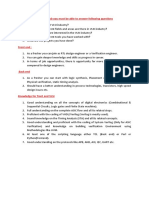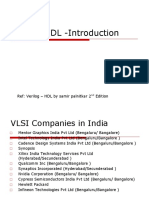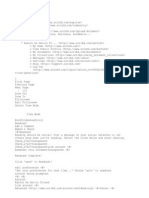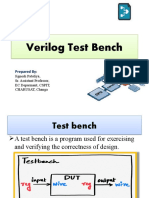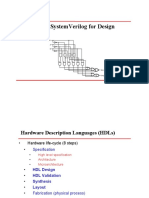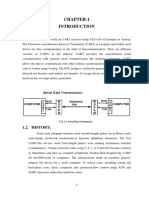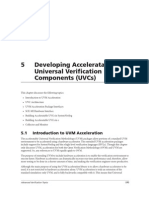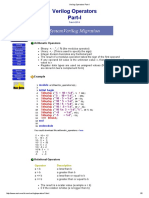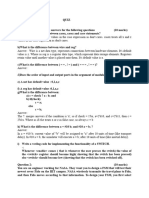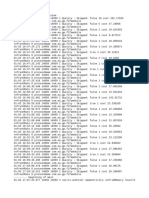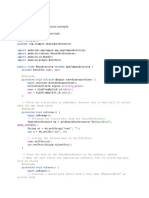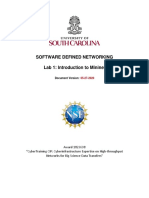Fall
10
Verilog HDL Introduction
Textbook: VerilogHDL A guide to digital design & synthesis Second edition Author: Samir Palnitkar
VLSI System Design
Verilog HDL
�HDL???
Fall
10
The principal feature of a hardware description language is that it contains the capability to describe the function of a piece of hardware independently of the implementation. The great advance with modern HDLs was the recognition that a single language could be used to describe the function of the design and also to describe the implementation. This allows the entire design process to take place in a single language, and thus a single representation of the design.
VLSI System Design Verilog HDL
2
�Verilog HDL
Fall
10
The Verilog Hardware Description Language, usually just called Verilog, was designed and first implemented by Phil Moorby at Gateway Design Automation in 1984 and 1985. It was first used beginning in 1985 and was extended substantially through 1987. The implementation was the VerilogXL simulator sold by Gateway. Present version: IEEE 1364-2001 Compliant
VLSI System Design
Verilog HDL
�What is Verilog HDL?
Fall
10
Verilog Hardware Description Language(HDL)?
A high-level computer language can model, represent and simulate digital design
Hardware concurrency Parallel Activity Flow Semantics for Signal Value and Time
Design examples using Verilog HDL
Intel Pentium, AMD K5, K6, Athleon, ARM7, etc Thousands of ASIC designs using Verilog HDL
VLSI System Design Verilog HDL
4
�Fall
Basic Design Methodology of HDLs
Requirements RTL Model Synthesize Gate-level Model ASIC or FPGA Place & Route Timing Model Simulate
10
Simulate
Test Bench
Simulate
5
VLSI System Design
Verilog HDL
�10 Modeling Digital Systems
Fall
Verilog HDL is for writing models of a system Reasons for modeling requirements specification documentation testing using simulation formal verification synthesis Goal most reliable design process, with minimum cost and time avoid design errors!
VLSI System Design Verilog HDL
6
�Fall
Domains and Levels of Modeling
Structural Functional
10
high level of abstraction
low level of abstraction
Y-chart due to Gajski & Kahn
Geometric
VLSI System Design Verilog HDL
7
�Fall
Domains and Levels of Modeling
Structural Functional
Algorithm (behavioral)
10
Register-Transfer Language
Boolean Equation Differential Equation
Geometric
VLSI System Design Verilog HDL
Y-chart due to Gajski & Kahn
8
�Fall
Domains and Levels of Modeling
Structural
Processor-Memory Switch
Register-Transfer
10
Functional
Gate Transistor
Y-chart due to Gajski & Kahn
Geometric
VLSI System Design Verilog HDL
9
�Fall
Domains and Levels of Modeling
Structural Functional
10
Polygons Sticks Standard Cells Floor Plan
Geometric
VLSI System Design Verilog HDL
Y-chart due to Gajski & Kahn
10
�Hierarchy
Verilog allows you to represent the hierarchy of a design. The Verilog structures which build the hierarchy are: modules, ports. A Verilog model is composed of modules. A module is the basic unit of the model, and it may be composed of instances of other modules. A module which is composed of other module instances is called a parent module, and the instances are called child modules.
Fall
10
VLSI System Design
Verilog HDL
11
�Hierarchy contd
A more common way of depicting hierarchical relationships is: We say that a parent instantiates a child module. That is, it creates an instance of it to be a submodel of the parent. Comp_1 System instantiates comp_1, comp_2. comp_2 instantiates sub_3.
Fall
10
SYSTEM
Comp_2
Sub_3
VLSI System Design
Verilog HDL
12
�Module
A module is defined like this:
Fall
10
A module can be an element or a collection of lower-level design blocks.
module <module_name> (<module_terminal_list >); . <module internals> Verilog HDL is a case-sensitive . language. All keywords are in endmodule
lowercase
Each module must have a <module_name> which is a identifier for the module, and a <module_termininal_list>, which describes the input and output terminals of the module.
VLSI System Design
Verilog HDL
13
�Module contd
Signifies starting of the module
module test (out , in1,in2); . statement1; statement2; . endmodule
Fall
10
Semicolon ; signifies termination of a module statement Name assigned to the module
Individual statements within the module
Signifies termination of a module
VLSI System Design
Verilog HDL
14
�Instances
Fall
10
The process of creating objects from a module template is called instantiation, and objects are called instances. Name assigned to the instantiation Name of the output lead Names of the input leads
nand_gate ic1 (b1,a8,a7,a1);
nand_gate ic2 (b2,c8,c7,c1);
A typical instantiation of a nand gate
nand_gate is the name assigned to the module. The nand_gate can be instantiated by the designer as many times as desired. Each instantiation has to be assigned identifier name (ic1, ic2 .. ). As part of the instantiation declaration, the input and output terminals are to be defined. The convention followed is to stick to the same order as in the module declaration.
VLSI System Design
Verilog HDL
15
�Instances contd
a1 The other way of instantiation is given as nand_gate ic1 (O(b), I8(a8), I7(a7), I1(a1) );
Fall
10
I1
I8
nand gate module ic1
a8
Each module can be defined only once. They cannot be nested. Any module can be instantiated inside another any number of times.
VLSI System Design
Verilog HDL
16
�Example
// 4-bit Ripple Carry Counter module ripple_carry_counter (q, clk, reset); output [3:0] q; input clk, reset; T_FF tff0 (q[0], clk, reset); T_FF tff1 (q[1], q[0], reset); T_FF tff2 (q[2], q[1], reset); T_FF tff3 (q[3], q[2], reset); endmodule
Fall
10
// Define the module T_FF. It instantiates a D_FF. module T_FF (q, clk, reset); output q; input clk, reset; wire d; D_FF dff0 (q, d, clk, reset); not n1 (d, q); // not gate is verilog primitive endmodule
// Define the module D_FF module D_FF (q1, d, clk, reset); output q1; input d, clk, reset; reg q1; always @(posedge reset or negedge clk) if (reset) q1 <= 1'b0 ; else q1 <= d; endmodule
17
VLSI System Design
Verilog HDL
�Levels of modelling
Switch level (Circuit level) Gate level
Fall
10
Data flow Behavioral level
VLSI System Design
Verilog HDL
18
�Switch level
Fall
10
This is lowest level of abstraction provided by Verilog. A module can be implemented in terms of switches, storage vdd nodes and the interconnection between them.
Example : // inverter module my_inv(out, in); output out; input in; supply1 vdd ; supply0 gnd; pmos p1(out, pwr, in); nmos n1( out, gnd, in); endmodule VLSI System Design Verilog HDL
in
out
gnd
19
�Gate level
Fall
10
This is next level of abstraction provided by Verilog. The module is implemented in terms of logic gates and the interconnections between these gates
and a1 (A, B, C); or and (A, B, C);
VLSI System Design
Verilog HDL
20
�Data flow
Fall
10
This is the next level of abstraction. At the data flow level, signals are assigned through the data manipulating equations. The design description are more compact than those at the gate level.
assign C = A & B;
VLSI System Design
Verilog HDL
21
�Behavioral level
Fall
10
Behavioral level constitutes the highest level of design description. A module can be implemented in terms of the desired design algorithm without concern for the hardware implementation details. Designing at this level is very similar to C programming. The behavioral level should contain atleast a initial or always block
VLSI System Design
Verilog HDL
22
�Lexical conventions
White space:
blank space (\b) tabs (\t) newline (\n)
Fall
10
White space is ignored by verilog except when it separates tokens
NOTE: Tokens can be comments, delimiters ( , and ; ), numbers, strings,
identifiers and keywords. White space is not ignored in strings.
Comments: One line comment starts with //
Multiple line comment starts with /* and ends with */ Multiple line comments cant be nested.
VLSI System Design
Verilog HDL
23
�Number specifiations
(-)<size>`<base format><number>
Fall
10
<size> : specify the size of the constant in the number of bits. (optional) 32-bit wide number by default <base format> : single character ` followed by one of the following characters b(binary), d(decimal), o(octal), h(hex) decimal by default
Examples
549 //decimal number `h 8FF //hex number `o765 // octal number 4`b11 // 4-bit binary number 0011 3`b10x // 3-bit binary number with least significant bit unknown 5`d3 // 5-bit decimal number -4`b11 // 4-bit twos complement of 0011 or 1101 this is a string // enclosed in double quotes
VLSI System Design
Verilog HDL
24
�Operators
3 types
Unary operators precede the operand
Fall
10
Example: a = ~ b; // ~ is a unary operator, b is operand
Binary operators appear b/w two operand
Example: a = b && c ; // && is binary operator, b and c are operands
Ternary operators have two separate operators that separate 3 operators.
Example: a = b ? c : d ; // ? : ternary operators. b, c, d operands.
Verilog HDL
25
VLSI System Design
�Fall
10
Ternary example:
reg y; always @ (a or b or select) if (select) y = a; else y = b; OR y = (select) ? a : b;
VLSI System Design
Verilog HDL
26
�Operators(1/8)
Arithmetic operators
Treats vectors as a whole value If any operand is x, then the results are unknown
Example : ain+ din = unknown
Fall
10
If results and operands are same size, then carry is lost
VLSI System Design
Verilog HDL
27
�Operators(2/8)
Bitwise operators
Operates on each bit of operand Result is the size of the largest operand Left-extended if sizes are different
Fall
10
VLSI System Design
Verilog HDL
28
�Operators(3/8)
Reduction operators
Fall
10
Reduces vector to single bit x is considered unknown, but result maybe a known value
Example: &din results in 1`b0
VLSI System Design
Verilog HDL
29
�Operators(4/8)
Relational operators
Fall
10
Used to compare values Returns a 1 bit scalar value of boolean true (1) / false (0) If any operand is x, then the results are unknown
VLSI System Design
Verilog HDL
30
�Operators(5/8)
Equality operators
Fall
10
Used to compare values Returns a 1 bit scalar value of boolean true (1) / false (0) If any operand is Z or X, then the results are unknown Case equality and inequality includes x
VLSI System Design
Verilog HDL
31
�Operators(6/8)
Logical operators
Fall
10
Returns a 1 bit scalar value of boolean true (1) / false (0) If any operand is x, then the results are unknown
VLSI System Design
Verilog HDL
32
�Operators(7/8)
Shift operators
Shifts a vector left or right some number of bits Zero fills Shifted bits are lost
Fall
10
VLSI System Design
Verilog HDL
33
�Operators(8/8)
Miscellaneous operators
Fall
10
VLSI System Design
Verilog HDL
34
�Operators precedence
Operators default precedence +, -, !, ~ (unary) +, - (binary) <<, >> <, >, <=, >= ==, != & ^, ^~ or ~^ | && || ?: (ternary) ( ) can be used to override default
VLSI System Design Verilog HDL Highest priority
Fall
10
Lowest priority
35
�Data types(1/6)
4 value logical system in verilog.
ZERO
Fall
10
ONE
UNKNOWN
HIGH IMPEDANCE
VLSI System Design Verilog HDL
36
�Data types(2/6)
3 major data types.
Nets
Represents physcial connection between devices
Fall
10
Registers
Represent abstract data storage elements
Parameters
Run-time constants
Declaration syntax
<data_type> [<MSB>:<LSB>] <list_of_identifier>
VLSI System Design
Verilog HDL
37
�Data types(3/6)
Nets
wire is the most common type
Fall
10
VLSI System Design
Verilog HDL
38
�Data types(4/6)
Register
reg is the most common type
Fall
10
VLSI System Design
Verilog HDL
39
�Data types(5/6)
Vectors
Fall
10
wire and register can be represents by vectors
wire [7:0]temp1 reg [7:0] temp1
Arrays
<array_name> [<subscript>]
integer temp [7:0] reg [7:0] temp[31:0]
VLSI System Design
Verilog HDL
40
�Fall
10
VLSI System Design
Verilog HDL
41









